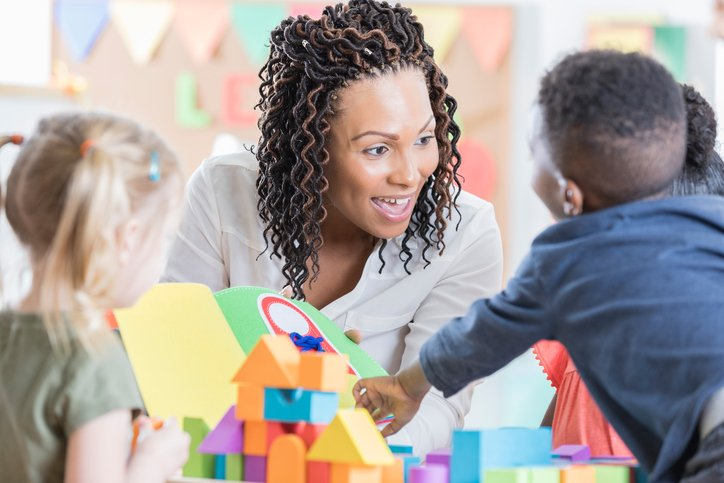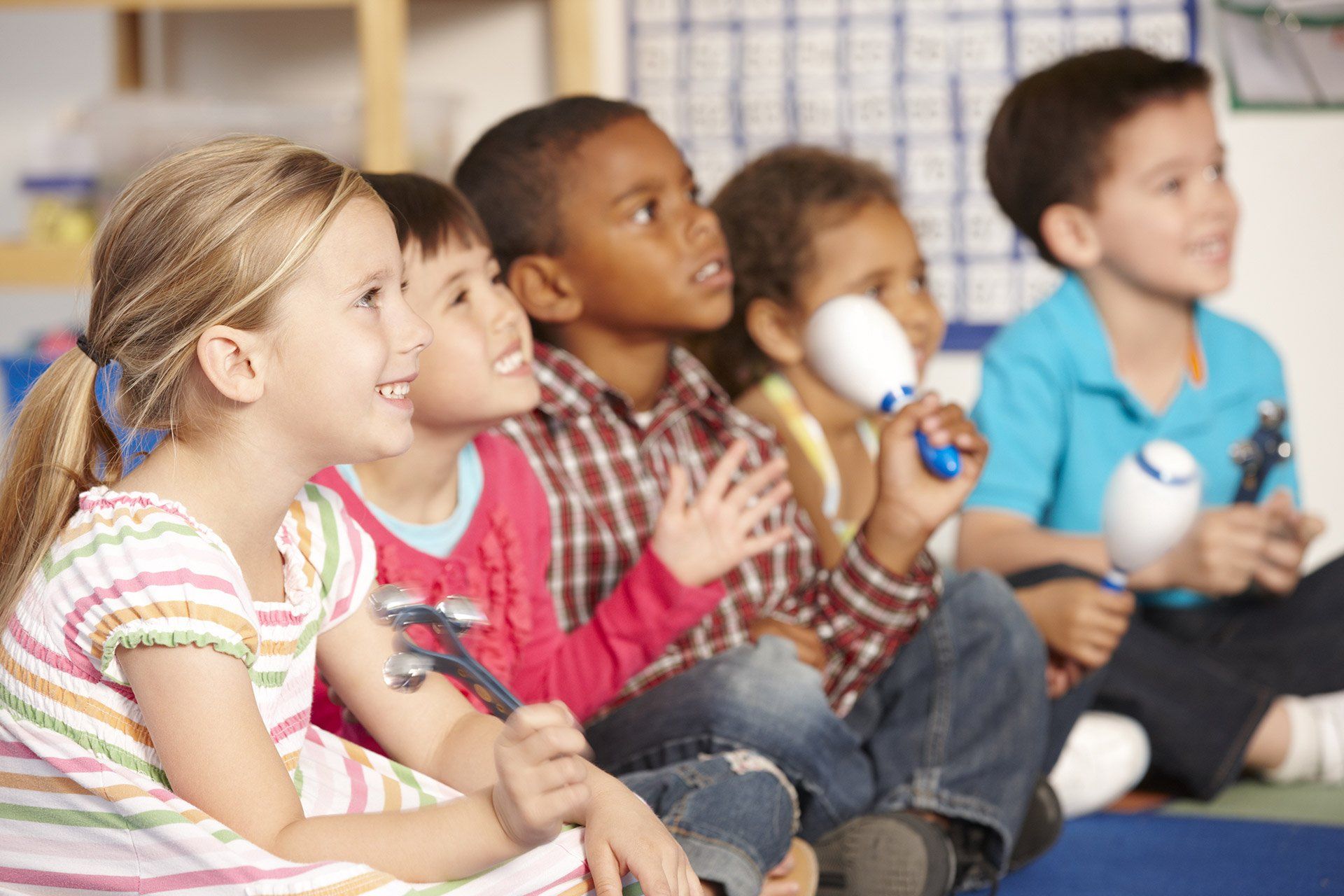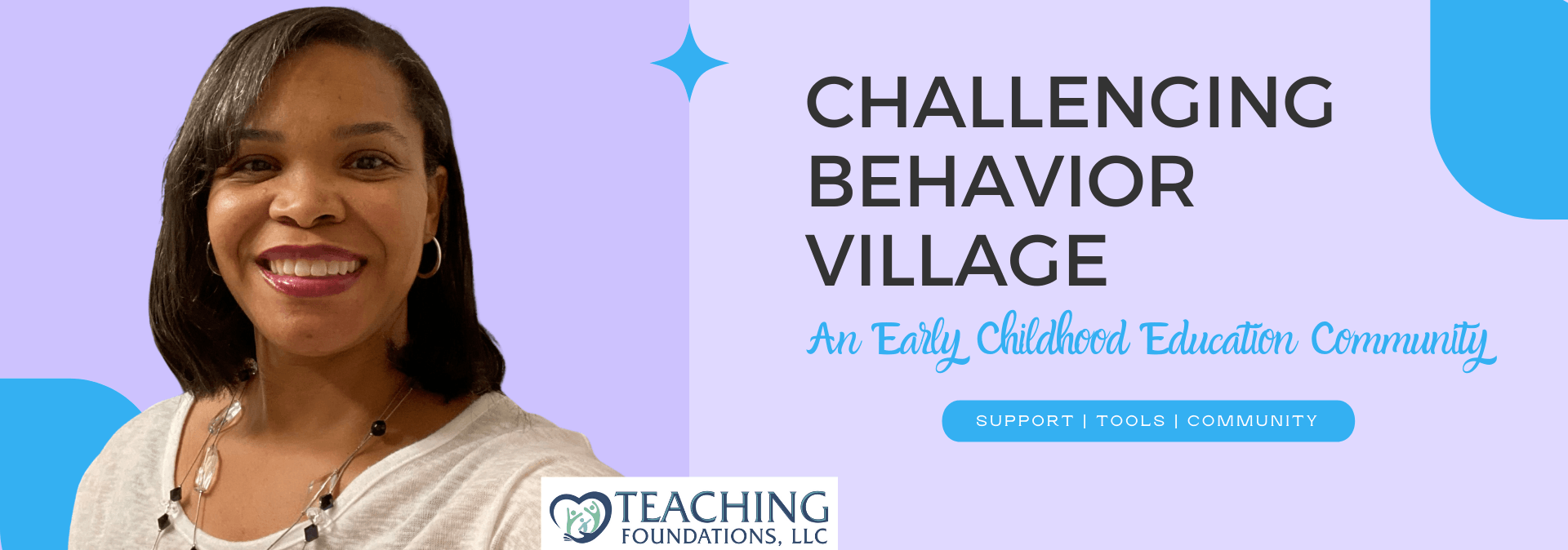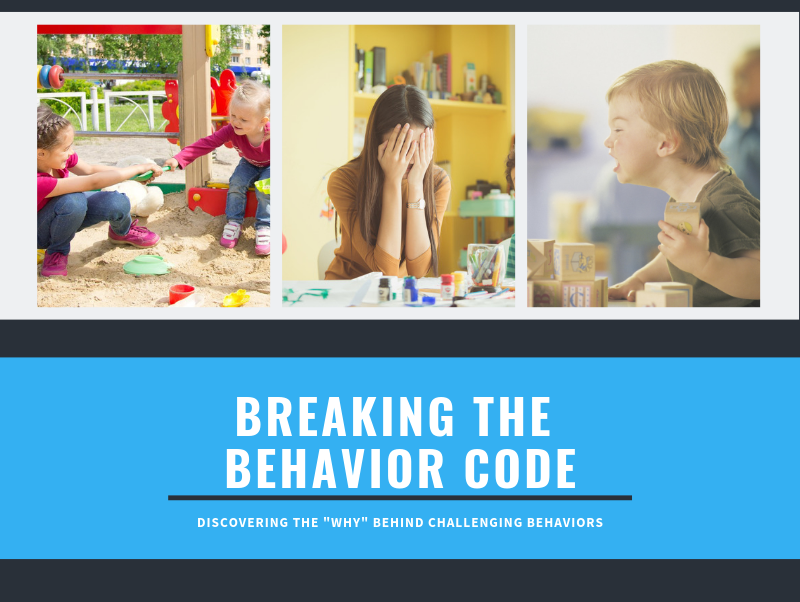
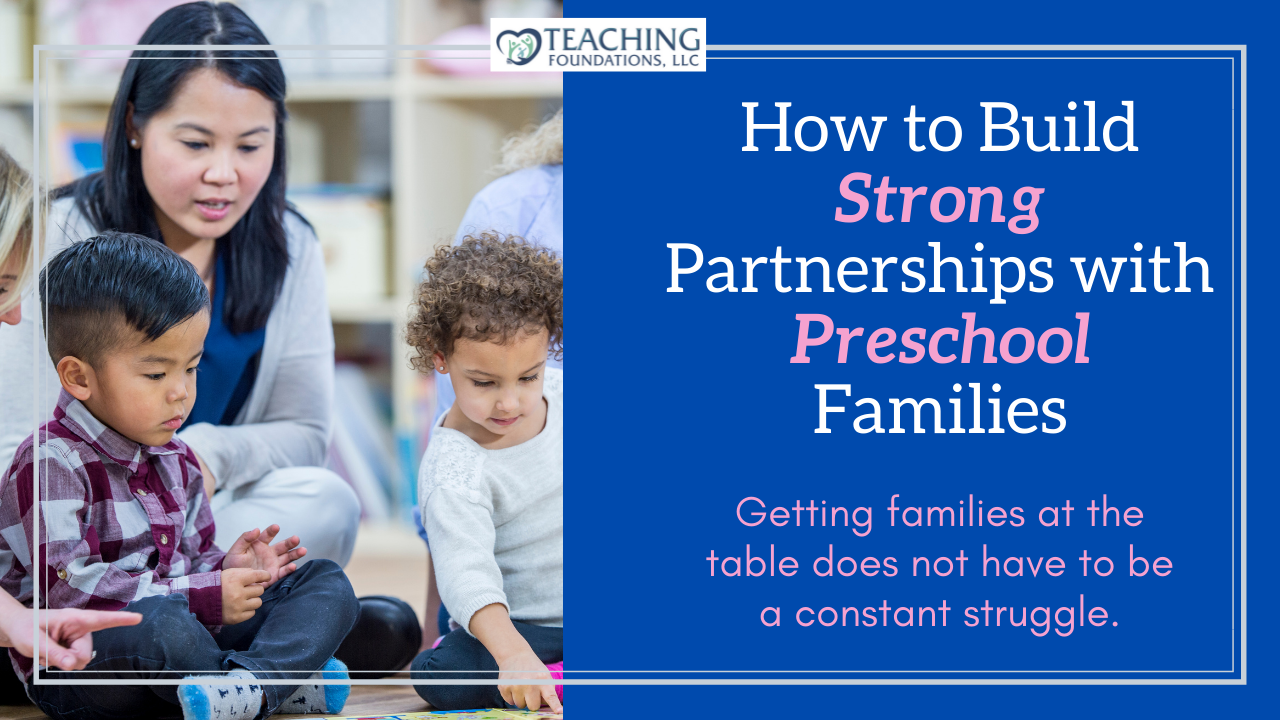
One of the most challenging parts of addressing challenging behaviors is getting parents to the table. Partnering with families can be the difference between successful outcomes for your behavior support plans or a year long struggle. In this article, I share ways I communicate with families so that they will actually listen. Download our free Behavior Brainstorming form!
When addressing challenging behaviors, the first step is tracking the behavior. This is an important first step because it allows you to plan your behavior supports and tools around the reasons for the challenging behavior. This post not only explains the benefits of tracking behavior, but also shares with you tips and tricks for making behavior tracking fit within your daily classroom routines.
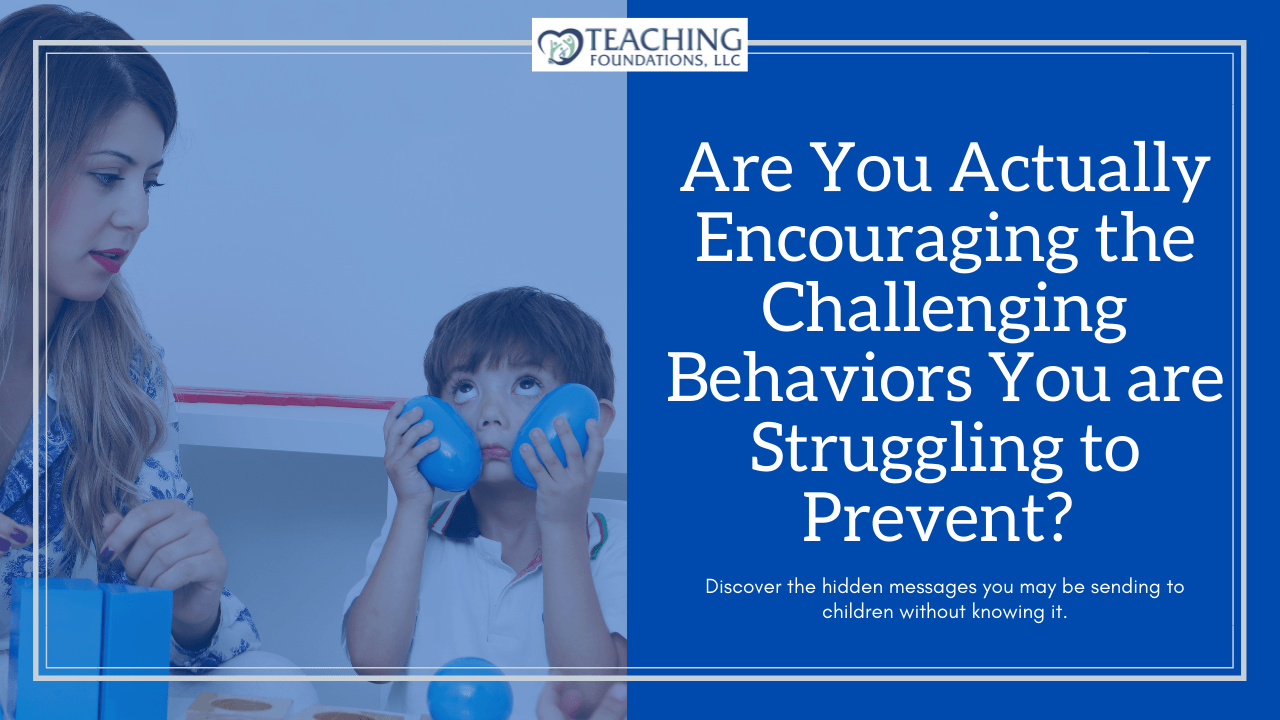
Have you ever had a child who despite everything you did, their behavior only continued to get worse? You’ve probably heard stories similar to this: “Drop off was a time of day I dreaded. Adrian would arrive in the morning with his mom and they would read a book together. When mom went to leave, Adrian would storm the door and run out of the classroom. We would have to chase him down the hall. If his mom saw him, she would come back to the classroom to talk to Adrian. At first, we thought the challenging drop off would go away once he got used to being in our classroom. However, it only increased over time with him starting to yell, cry, and throw things when his mom left for work. This became a part of our morning routine to the point of administrators needing to come to our classroom to assist. Each morning would melt down into chaos that disrupted our morning routines. It was a nightmare to say the least.“ I shared this example with you because this is a time when many of us question our abilities as a teacher. I’ve had many similar moments in my teaching career. These moments taught me a lot about working with children with challenging behaviors. They also helped me think about my role in helping the children in my classroom. Looking back, one of the reasons I struggled so much was I didn’t take the time to reflect on the big picture about the challenging behaviors and my role in it. Now, reflection has become a big part of how I plan my response to challenging behaviors. It is also a major factor in my ability to maintain composure and perspective. In this article, I’m showing you how I reflect on the big picture of children's challenging behaviors and adjust my interactions to actually see progress when working with the children with challenging behaviors in my classroom.
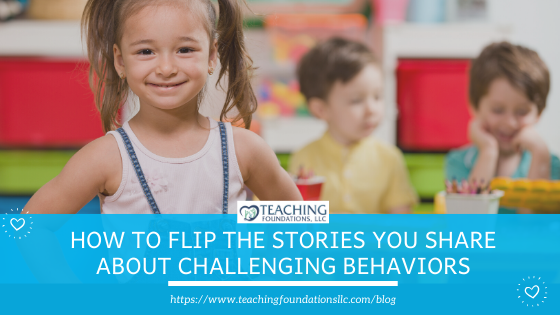
Why is it that the children who need our love and support the most are the last ones to receive it? I have asked myself this question many times. It is something that drives my work and passion for children with challenging behaviors. This question has also led me to many obvious conclusions – we don’t know how to support them, their needs are hard to address in a group setting, and what about the others (aren’t they losing out)? This question is at the center of many conversations related to supporting children with challenging behaviors. You hear about it when advocates discuss the importance of social skills on later success in school and life . My exploration of the question has led me to a possible answer that has yet to be considered.

It’s the beginning of the year and most of us are preparing our classrooms for the arrival of our students. We are arranging furniture, putting up decorations and displays, creating daily schedules, and planning our daily activities. However, there is one thing missing from this preparation. It is often the one thing that is the difference between having a classroom full of children who know and follow our schedules and a classroom full of children who need constant reminders and redirection to meet our expectations. It is the difference between saying, “I have the best class ever!” and “I can’t wait till summer starts!” What is it you’re asking……
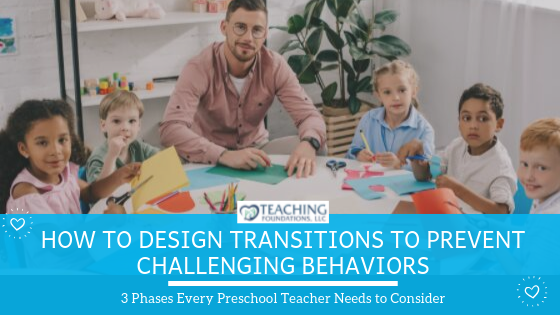
Are you struggling with the transitions in your classroom? Do you feel like you lose control of your room when transitioning between activities? Learn the 3 phases of transitions and how you can design a transition plan that keeps you in control while reducing the challenging behaviors associated with preschool transitions.
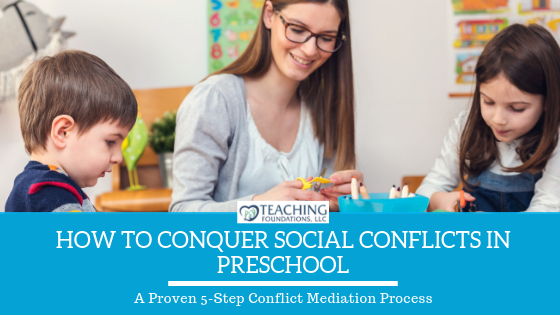
Social conflicts are everywhere in a preschool classroom. Children fighting over toys in the block area, calling each other names, saying, "You can't come to my party", and pushing to be the first in line are all common social conflicts encountered by preschool teachers. Learn the 5-steps you can take to conquer these social conflicts and teach children how to problem solve at the same time.
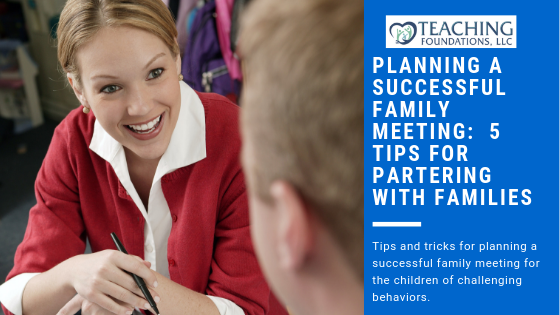
An important part of working with children with challenging behaviors is meeting with parents to create a behavior support plan. For most preschool teachers, this meeting can be intimidating as you work with resistant and defensive families. I share with you my 5 tips for creating successful behavior support meetings with the families of children in my programs. Using these tips in your classroom is sure to bring strong, more connected partnerships with the families in your room.
Have you started tracking the challenging behaviors in your classroom and now you're wondering what to do with all the documentation? Collecting information about children's challenging behaviors only works if you know what to look for in all the information. This article will introduce you to the 5 needs behind all human behaviors. You will also learn signs of each need in children's behaviors and how to adapt your classroom environment and routines to meet each of the 5 needs.
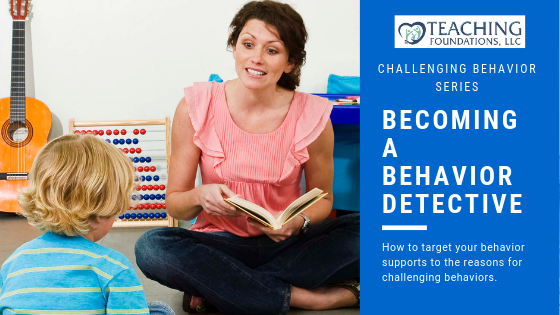
Are you struggling with finding the right strategies and tools to manage the challenging behaviors in your classroom? Do you feel like you have tried everything and nothing works? Learn 3 questions every preschool teacher should be asking when planning supports for children with challenging behaviors.
Hi Everyone! I am the founder of Teaching Foundations, LLC. I have over 20 years experience in the field of Early Childhood Education. I share with you strategies and tools for managing challenging behaviors that I have learned as a classroom teacher, curriculum specialist, and behavior consultant. Let's conquer challenging behaviors together!
Join our community of early childhood teachers who are all working to conquer challenging behaviors in their classroom. Find a supportive community full of resources, tools, and strategies. Click the image above to join today!
Do you have a process for addressing challenging behaviors in your early childhood program? Our live, instructor-led virtual training, Breaking the Behavior Code: Discovering the "Why" Behind Challenging Behaviors will teach you our 5-step process. Sessions running in July and August.
Follow us on Instagram
I frequently hear this comment in my discussions about children’s behaviors, “He just wants attention!” A child wanting (or needing) attention is received as manipulation, controlling, and many other negative associations.
However, we suddenly feel empathy for the child when we flip the script to say, “He’s seeking connection”. We want to spend time with the child.
The only difference between the two words is the meaning we associate with them. It’s ok to want to be connected to others, it not ok to want others attention. I challenge that we only want the attention of those with whom we have a relationship. In the end, it’s all about how can we make our relationship stronger with the child.
So the next time you find yourself saying, “He wants my attention.” Change it to “He wants to connect with me.” Then, see how your response to the child’s behaviors change.
#behaviormanagement #preschoolteachers #earlychildhoodpedagogy #challengingbehaviour #sundayinspiration #teachingfoundationsllc #challengingbehaviorvillage #teachersfollowteachers
I’m so excited to jump into this book. Dr. Teresa Byington was the keynote speaker and trainer and the trainers conference I participated in yesterday. Her ideas on bringing “joy” into our work were definitely inspiring. It’s something I’m always saying to those I am privileged to work with - you have to find what brings you happiness. If there is no “joy” working with children in any capacity can become draining. I always try to find “joy” in the little moments, successes, interactions, celebrations! That is how I survived 20 years in our field.
How do you find “joy” in your work?
#earlychildhoodeducation #preschoolteachers #preschoolteacher
#headstart #headstartprogram #selfcaresaturday
Looking for FREE resources and tools for addressing challenging behaviors? Our Challenging Behavior Village is the place to be! It’s full of resources, tools, and people who are supportive! Join the group today to access our weekly trainings, as we learn and grow together.
What are you waiting for?
Click the following link in our bio to join today!
#challengingbehaviorvillage #teachingfoundations #preschoolteacher #preschoolers #emotionalintelligence #selfregulationskills #selfregulation #earlychildhoodeducationteacher #teachersfollowteachers
Yesterday, I had an amazing day as I led two training sessions at a local school. We discussed “discipline is teaching” and “positive words for positive action”. It was great discussing the children in their school and the strategies that could work to help all the children participate successfully in their classroom routines.
Growth happens on both sides - the programs and the child’s.
#challengingbehavior #earlychildhoodeducation #disciplineisteaching
#preschoolisfun #preschooltraining #positivewords
The biggest challenge when helping children learn to self regulate is understanding the developmental progression. Sometimes we jump to the end - regulation - without first taking the time to see where children are with identifying and recognizing how they express emotions.
A comprehensive approach to helping children learn to self regulate includes helping children learn and build an emotions vocabulary, recognize how they express different emotions, and strategies they can use to help manage their emotions.
When we do all three, we are taking strides to helping children - and eventually adults - build a lasting mental health toolbox.
#mentalhealth #emotionalintelligence #earlychildhoodeducator #earlychildhoodsped #earlychildhoodpedagogy #teachertipsandtricks #teachertips #mondayinspiration #preschoolteacher #toddlerlife
So excited to be reading this book! Pre-ordered it and now diving in! Stay tuned for insights learned. 🤓
#brainbodyparenting #wholebrainlearning #positiveguidancegirl #positivediscipline #preschoolteacher #childcareteachers #preschoolteachersofinstagram #parenting101 #headstartteacher @monadelahooke
Teacher burnout is a real thing. It is a significant factor in high staff turnover and quality of care. Stress plays a big part in teacher burnout. The challenge for me is am I aware of what is causing me stress and how I’m responding to it.
I use my stress tracker log to note times when I feel overwhelmed, anxious, and frustrated. By logging these moments, I am able to become aware of my emotional triggers and plan ways to address the stressors in my life. While some stressors are unavoidable, the log gives me back a sense of control as I am better able to predict and respond to triggers in my work environment.
When I see a lot of stress present in my day, it tells me to pause, reflect, and take a moment to care for myself. If I do this, I am reducing my chances of burning out before it’s too late.
What do you do to become more aware of what’s causing you stress at work? What are you go to self-care strategies when feeling overwhelmed.
#teacherburnout #teacherselfcare #earlychildhoodeducation #earlychildhoodteacher #iteachpreschool #iteachpreschoolers #teachersofinstagram #preschoolteachersofinstagram #preschoolteacherlife #preschoolteacher #preschoolteachers #iteachprek #selfcare #mindfulness
January we’re focusing on emotions and self-regulation (is that even possible) in our Challenging Behavior Village group!
Struggling with tantrums, aggressive behavior, or meltdowns? Then, this month’s focus is meant just for you.
Click the link in our bio to join our Challenging Behavior Village for weekly trainings. Also, sign up for our weekly newsletter to get access to all of this month’s freebies from the blog!
Share your biggest challenges with emotions and self-regulation in your classroom?
#emotions101 #preschoolteacherlife #preschoolteacher #socialemotionaldevelopment #socialemotionaleducation #socialemotionalcurriculum #iteachprek #iteachpreschool #earlychildhoodspecialeducation #earlychildhoodeducator #headstartteacher #emotionalregulation #selfregulationskills
Are you struggling with challenging behaviors and looking for resources and and strategies for working with preschool age children? Our blog is full of content just for early childhood teachers. From answering the question “why is he doing this” to working with resistant families, we have something that will help you take back control of your classroom.
Check it out by clicking the link in our profile. New content is added every Thursday!
#iteachprek #iteachpreschool #iteachpreschoolers #preschool #preschoolteachers #teacherblogger #teacherbloggers #teacherbloggersrock #challengingbehavior #challengingbehaviour #preschoolbehavior #headstart #headstartteacher #earlychildhoodspecialeducation #earlychildhoodeducation #earlychildhoodteachers #earlychildhoodteacher #preschoolteachersofinstagram #prekteachersofinstagram #prekteachers #toddlerteacher
One thing that used to frustrate me when I first started teaching was a parent saying, “Well, he doesn’t do that at home”. My reaction was always disbelief because I knew the child HAD to do it at home. Right?
I’ve learned over the years that sometime this statement is true - the effect of different environments - but most of the time this statement is protective. The parent is doesn’t want to admit their child is struggling, so they deflect to say the problem is your school or your classroom, etc.
When this happens, I don’t get frustrated. Instead I keep this statement in mind because a parent truly does need to hear and see struggles over and over to ask, “does my child need help?”
So, keep sharing, giving ideas and resources, and working to establish trust with the family. When they’re ready, you’ll be the first person they reach out to for help.
#preschoolbehavior #iteach #iteachprek #iteachpreschool #toddlerteacher #ece #challengingbehavior #challengingbehaviors #headstartteacher #headstart #preschoolteacherlife #preschoolteacher #preschoolteachersofinstagram #prekteachersofinstagram
New on the Blog - How to Build Strong Relationships with Preschool Families!
Have you told yourself, “These parents just don’t care?” We all have moments when it feels like we’re debating families or worst they’re non-existent.
In this post, I share how I build trust with the families to they will participate in the behavior support process. It’s not as hard as you think!
Read more by clicking the link in my bio!
#preschoolbehavior #iteachpreschool #iteachprek #ece #teacherhack #classroomsupport #classroommanagement #classroommanagementstrategies #toddlerteacher #preschoolteacherlife #preschoolteachers #headstart #headstartteacher #prekteacher #prekteachers #prekteachersofinstagram #preschoolteachersofinstagram #behaviorsupport
Some one new will be joining our feed and videos! Introducing Hedgy - my hedgehog puppet.
Inspired by Barb O’Neill of @transformchallengingbehavior, I finally got a puppet to share with the children in my program after two years of hearing about them in her annual conference. He was immediately a hit. They loved petting him, feeding him (carrots from dramatic play), and talking to him. He has even visited for story time and listened to books. It’s amazing how much the children have taken to him. Looking forward to getting more for all of our classrooms.
Puppets are a great way to model social skills and problem solving, teach empathy and caring for others, as well as, engaging children in conversations. Looking forward to sharing more of our adventures with Hedgy!
Do you use puppets in your classroom?
#preschoolbehavior #ece #teachinglittleminds #iteachprek #iteachpreschool #challengingbehaviors #childrensmentalhealthmatters #classroommanagement #puppets #preschoolteacherlife
New You Tube Video -
Are you struggling to get families to the table to address challenging behaviors? Building strong relationships with families in preschool does not have to be challenging. In our latest video, learn how to communicate with families so that they will listen, the concerns that may be keeping families from working with you, and tools you can use to build trust with resistant families.
Click the link in our bio to watch the video today!
#iteachprek #iteachpreschool #positiveguidance #teacherhacks #ece #ecewins #challengingbehaviors #toddlerteacher #classroommanagement #kidsemotions #teachinglittleminds #tfvillage
Are you struggling with children acting out to get your attention?
Remember, challenging behaviors are a child’s way of communicating what they need from you. So in this case, the child needs to feel connected with you. By proactively meeting the child’s need before the challenging behavior occurs, you are eliminating the need for the child to act out.
Who would you rather connect with: the child whose happily playing or the child whose frustrated and upset? 🤔
#teachinglittleminds #iteachprek #emotionaldevelopment #challengingbehaviors #teacherhack #classroommanagement #classroommanagementstrategies #ece #kidsemotions
Hi Everyone! It’s me, Tiffany - the person behind Teaching Foundations, LLC. I wanted to come on and do a #welcomewednesday post to everyone in our village.
I started Teaching Foundations because I am a helper and wanted to share strategies and tools that have helped me be successful working with all the children I’ve been blessed to teach over the years. My passion has always been learning and sharing. My vision is to build a community of teachers who are all dedicated to changing the conversations we have about children with challenging behaviors.
A few things about me:
🦋I am a mother of two amazing children. It is because of them that I want to ensure that every child has a opportunity to learn and grow together.
🦋I am a lover of sports: basketball, football, and ice skating ⛸! (Can’t wait for the Winter Olympics)
🦋I love to read. Barnes and Nobles is definitely a budget killer for me.
🦋My educational background includes both psychology and education training. While I’m in the education field, psychology influenced all of my approaches to classroom management and challenging behaviors.
That’s a little about me! Looking forward to sharing and learning more as our village continues to grow in the new year!
#socialemotionaldevelopment #socialemotionalskills #childcarecenter #headstartteacher #behaviormanagement #earlychildhoodactivities
ADHD, Autism, Down Syndrome - do you use these labels when asked “what does the child need?”
Labels are helpful when trying to understand why a child may be struggling at certain times of the day, but they are NOT what the child needs to be successful in your program.
Also when we focus only on labels, what about children with needs and no labels? Do they fall through the cracks with no supports?
I’m not against labels, but I also am very aware of what they do…sometimes they keep children in boxes (being solely defined by their label) and keep others from accessing the supports their behaviors are “screaming” they need.
It’s definitely time to get beyond looking for labels and start asking, “How can I help this child be successful in our school, program, classroom?” This is the beginning of a truly inclusive educational community.
Follow @teachingfoundations or #tfvillage for challenging behavior supports, resources, and tools.
#challengingbehaviors #earlychildhoodeducation #earlychildhoodeducators #preschoolteacher #behaviorsupport
During one of my recent trainings, it was mentioned that children today are different than we were as children. This may be true because children today have a completely different childhood experience. From smart phones, iPads, YouTube, and other forms of technology, children are growing up exposed to more information. Additionally, the need to self-directed play is replaced by being entertained with technology.
The thing we have to remember is that, because children’s experiences are different, we also need to change how we guide and nurture today’s children. The rise in challenging behaviors, anxiety, and other disorders reflects the need for us to adapt our approaches from those used in the past.
If children of today are different, it means they need different strategies than were used with us. Strategies that reflect their current experiences, challenges, and abilities. If we are to make progress with today’s child, we must start with meeting them where they are.
#challengingbehaviors #childguidance #earlychildhoodeducation #earlychildhoodeducator #earlychildhoodeducators #headstartteacher #headstart #socialemotionallearning #behaviormanagement
When planning strategies to support challenging behaviors, there are four things I consider: child’s temperament, context, indicators, and support.
Temperament is the child’s energy level, how they adjust to sudden changes (adaptability), and how they approach new situations and people.
Context is the people, places, and things that influence the child’s behavior (positively or negatively).
Indicators are what the child looks like when they are challenged, as well as, when they are successful.
Support is the strategies already in place that help the child.
Knowing these four things helps us ensure that the support plan meets the child where they are developmentally and that it is based on both the child’s needs and strengths.
Follow @teachingfoundations for resources and tools to target behavior supports to the reasons behind challenging behaviors.
#challengingbehaviors #behaviormanagement #behavioranalysis #preschoolteacher #headstart #headstartteacher #earlychildhoodeducation #earlychildhoodeducator #behaviorsped #tfvillage
We can see different challenging behaviors in our classrooms - hitting, throwing, yelling, eloping. While the actual behavior looks the same in different children (hitting is hitting), why children are doing the same behavior will be for different reasons.
This is why it’s important to select strategies for addressing challenging behaviors based on why they are happening, not the actual behavior itself.
Think about a child hitting because some one someone took their toy - telling them to breathe or use other calming methods won’t reduce their chances of hitting. This child needs to be given the words to ask for his toy back.
So the next time you are asking for strategies to address a behavior challenge, also share a little of the context and why it may be happening. This will ensure that the strategies shared target why the behavior is happening and increase your chances of reducing occurrences in the future.
Need help with this?
Join our Challenging Behavior Village Facebook by clicking on the link in our bio!
One of the most common questions I’m asked by teachers I work with is “What do I do while I’m tracking the challenging behavior in my classroom?” No one wants to sit back and do nothing for two weeks! I totally agree. Listen to find out two things you can do to address challenging behaviors while you are gathering the information you need to create behavior support plans.
#challengingbehaviors #tfvillage #preschoolteachers #preschoolclassroom #behaviormanagement #behaviorchart #preschoolbehaviorproblems #earlychildhoodeducation #earlychildhoodeducator #headstart #headstartteacher #behaviorspecialist
Just put together my Behavior Tracking Workbook! In it, I have the Behavior Support Guide, Behavior Brainstorming Form, and the forms I need to track any challenging behaviors happening in my classroom.
Being prepared ensures that I will actually keep the needed information when later creating behavior support plans.
Behavior does not happen in a vacuum. There are many different influences on how a child behaves. When asking, “Why did she hit”, I have to consider what was happening at the time, what I was doing, and even how I (and the other children) responded after she hit. That’s a lot to think about in the moment.
One thing I do know is that the two biggest influences on a child’s behavior is the relationship that child has with me (and the other children in the class) and the messages my environment sends to the children. By consistently working to foster warm, caring relationships and a sense of community where everyone belongs, I tell every child that they are an important part of our classroom community. By ensuring my environment matches the interests, skills, and abilities of the children, I send messages that yes this is a safe place to learn.
I spend the month of September getting to know the children and adapting my interactions, expectations, and routines to ensure I have a place where everyone can learn. It’s a small first step - but a big one in terms of progress.
How do you build your classroom community so everyone feels like they are a valued and important part?
One way to engage the children in conversations about social skills is by reading books with social problems. Watching the children discuss the problem and make suggestions for what Llama can do gives me insight into how my children think about social problem solving.
These two books are a must read in the beginning of the year, especially when creating classroom rules for the children. Things they share during the story discussions can easily be adapted into classroom expectations for playing with their peers during the year.
The best part is social-emotional learning is embedded into your group time, story time, or the down moments when you are waiting for lunch to arrive.
How do you embed social-emotional learning into your classroom routines?
#classroommanagement #socialemotionallearning #preschoolteacher #preschoolclassroom #earlychildhoodeducator #headstart #challengingbehaviors #challengingbehavior
There is more to creating a schedule than listing times of days and activities. How will you get the children to do what you want them to do during each part of the day. Watch this video to learn how to plan your daily routines so you can start teaching the children what to do from the first day.
Learn more about creating routines by checking out the blog post “How to Conquer Your Year with Successful Routines” by clicking the link in our bio!
Follow our page to learn more classroom management strategies for working with preschoolers.
#classroommanagement #socialemotionallearning #earlychildhoodlearning #earlychildhoodeducation #earlycareandeducation #challengingbehaviors #preschoolteacher #earlychildhoodeducator #earlychildhoodeducators #preschoolclassroom
I use this classroom routines tool to plan out what I want to do with the children. It helps me focus on what I want the children to do during the different times of my schedule. Once I know what I want them to do, I can plan out how I’m going to teach this to the children.
This is a great resource to share with those who are assisting in your room. Now they have something they can refer to when helping in your classroom that keeps your routines consistent.
Times when I use:
✏️ It’s the beginning of the year
✏️ I need to adapt my routines due to challenges or struggles.
✏️ If I have a child who needs specific supports at specific times of day - I add the adaptations to the routines box.
How would you use this tool?
Want this resource? Access it by going to our free resources page at the link in our bio.
#earlychildhoodeducator #preschoolteacher #classroommanagement #headstart #headstartteacher #beginningofschoolyear #teacherlife🍎 #challengingbehavior #tfvillage
When I first started teaching, I saw the behavior challenges in my room as “problems” that needed to be fixed. There were also times when I saw my struggles to address children’s behaviors as a reflection of my abilities as a teacher.
One thing I’ve learned the longer I’ve been in this field is that challenges present opportunities for growth. In particular, behavior challenges are opportunities to take the time to learn more about the children in our classrooms: what motivated them, what gets them excited, and who they are as little people in this world. The more we get to know them, the better teacher we become for them.
Now, I see a child struggling in my classroom and I stop to learn more about the child. I spend more time with them, keep track of times of day that are challenges as well as times that are exciting and fun. I take time to ask questions of families to learn more about what is happening in the child’s home life. Simply, I take the time to get to know as much about the child as possible. Behavior tracking isn’t a burdensome task I hate to do. It’s something I see as vital to knowing how I can adjust what I do to be a better teacher for the children I have in my room.
How do you turn behavior challenges into a learning opportunity?
#challengingbehavior #tfvillage #earlychildhood #earlychildhoodeducator #preschool #preschoolteacher #preschoolteacherlife #preschoolclassroom #earlychildhoodeducation #classroommanagement
New on the Blog: Why Tracking Behavior is the MOST Important Thing You Will Do
We hear it all the time “Behavior is Communication!” But what does that actually mean. In this week’s article, I share how tracking behavior helped me target my behavior supports to the reasons driving challenging behaviors, what to look when tracking challenging behaviors, and how to incorporate behavior tracking into your daily classroom routines and schedules.
Check out the article by clicking the link in our bio!
#behaviormanagement #behavioranalysis #challengingbehaviors #earlychildhoodeducator #tfvillage #preschool #preschoolteacher #prekteacher #classroommanagement
New in the Resource Library: Behavior Brainstorming Form
Have you found yourself asking a lot of questions about the challenging behaviors in your classroom? Our Behavior Brainstorming Form is a great resource to use when trying to gather all the information in one place. There’s space to reflect on a child’s strengths & interests, list specific behavior challenges and challenging times of day, as well as space to list what questions you still have. It is a great tool to complete when preparing for meetings with parents.
Get yours today in our Free Resource Library. Access the Resource Library through the link in our bio.
#challengingbehavior #tfvillage #behaviorguidance #preschool #preschoolteacher #earlychildhoodeducation #earlychildhoodeducator #behaviormanagement
Did you know that Teaching Foundations offers the required Basic Health and Safety and Breastfeeding Awareness course for child care staff in Maryland. The best part is you can take this course live virtually with us from your office, classroom, or home.
Wondering what this course covers? The 10 Key Topics presented in this course include:
*Prevention and control of infectious
*Administration of Medication
*Prevention of and response to emergencies due to food and allergic reactions, and care of asthma
*First aid and cardio pulmonary resuscitation (CPR)
*Prevention of Sudden Infant Death Syndrome and safe sleep practices
*Prevention of Shaken Baby Syndrome and abusive head trauma
*Building and physical premises safety
*Handling and storage of hazardous materials
*Precautions in transporting children
*Emergency preparedness and response planning
If you are need of Health & Safety Training or just need a refresher, check out our course library today. We have sessions available in both July and August.
Find out more info here: https://www.teachingfoundationsllc.com/services/courselibrary
Do you have a calm down box? I like to keep a box of items that the children in my classroom can use when frustrated, angry, or overwhelmed to help them calm down. If you use the zones of regulation, the calm down box works great when children are in the yellow zone. ⚠️
I ensure the calm down box has items that appeal to the senses as well as fidgets and the always popular bubbles.
What items do you include in the calm down box in your classroom?
#challengingbehavior #behaviormanagement #behaviortherapist #preschool #headstart #headstartteacher #earlychildhoodeducation #earlychildhoodeducator #earlychildhoodteacher #tfvillage
A big area of worry for many new and experienced teachers is how to give directions so children will listen. We read books, watch our co-workers, and consult guides all in the hope of finding a magic way to get children to willingly go along with what we tell them they need to do.
In this video, I give three things every teacher should do when giving directions to the children in your classroom. So if you’re struggling with getting the children to listen, this video is for you. While there is no “magic wand”, these strategies are sure to increase your chances of success. 🙌🏾
Share in the comments below the techniques or strategies that work for you when giving children directions?
#challengingbehaviors #behaviorguidance #classroommanagement #preschool #earlychildhoodeducation #tfvillage
There are so many influences on children’s challenging behaviors, we can sometimes forget the role we play as teachers. The one area where we have the most control is in how we respond, the stories we tell ourselves, and how we communicate about the behaviors to others. How we respond is just as important as the strategies we use and the buy in we get from families.
#challengingbehaviour #challengingbehavior #behavioranalysis #behaviormanagement #preschool #preschoolteacher #headstart #earlychildhoodteachers #earlychildhoodeducation
New on the Blog:
When I first entered the teaching field, I was overwhelmed by children who exhibited challenging behavior. Many days would melt down into chaos as children climbed on furniture, hit each other, and otherwise would not willingly go along with my classroom routines. I spent many days wondering if teaching was the job for me.
The one thing that helped me begin to find success with supporting the children's behavior needs and maintain a sense of predictability in my day was REFLECTION. Through reflection, I was able to uncover the hidden messages in my responses to children's challenging behaviors.
So if you're finding the challenging behaviors in your classroom keep increasing despite your best efforts, read our latest blog post to learn how reflection on behavior episodes can be a game changer for you!
Click the link in our bio to read the article today!
#challengingbehaviors #preschool #earlychildhoodeducation #behaviorguidance #challengingbehavior #headstart #earlychildhoodeducator #behaviormanagement
There are some days when I’m working in the classroom I think, I wish……. or if only…
How do you complete these phrases? What things do you wish for when working with children with challenging behaviors?
#challengingbehaviors #earlychildhoodeducation #earlychildhoodteacher #earlychildhoodteachers #headstart #headstartteacher #behavioranalysis #preschoolteacher #preschool
One of my go to authors for understanding children’s emotional development and responses is Dan Siegel. His No-Drama approach to guiding behavior starts with of all things - Relationships 🤔.
I have used the techniques I’ve learned in these books to build my understanding of how children’s brains process emotions and thus change how I approach tantrums and explosive episodes.
What are your go to books for addressing challenging behaviors? What resources and people do you follow for ideas and strategies?
#challengingbehaviors #nodramadiscipline #preschool #behaviorguidance #classroommanagement #earlychildhoodeducation
The first step in addressing challenging behaviors is tracking the behavior. The ABC chart in our behavior toolkit is perfect for logging incidents of challenging behavior. Over time, this form will allow you to “see” the behavior patterns you may be missing - behaviors triggers, rewards for the child, common times of day, etc.
If you are struggling with finding solutions or strategies that work, take time to track the behavior and see what you uncover about “why” the behavior is happening.
What forms do you use to track challenging behaviors in your classroom/program?
One of the questions I hear most in my work with #preschool teachers is “what do I do”? When I hear this question, I know they are looking for strategies and tools. My response to them is usually questions:
What behaviors are happening?
When do the behavior occur?
What have you tried?
I sometimes get crazy looks or fits of frustration in response. 🥴
But the thing we have to remember is that pulling strategies out of a hat and hoping they work is a recipe for disaster when working with challenging behaviors. Yes! Sometimes you get lucky, but more often you find yourself trying things that don’t work or lead to frustration.
When working with young children, you need a process to guide you in your response to challenging behaviors. That’s what the 5-steps are for. (Make sure you swipe to see what they are.) The 5-steps are your guide to ensuring that the strategies you use to address challenging behaviors target the actual reasons behind them. While it takes time to follow, it actually saves you time in the long run!
What is your process for addressing challenging behaviors? What approaches to challenging behaviors have worked for you? Which ones haven’t? Share your thoughts and ideas below 👇🏾
Hi Everyone! Happy Monday!
I wanted to stop by share with you some great things that are happening at Teaching Foundations over the next few months. We have been challenged to create 30 days worth of content on our social media channels by @louisehenry . So this is the first of many daily posts you will see from me.
Behind the scenes, we have been working hard to bring you fresh new content from our blog. Make sure you follow us on Instagram and Facebook to stay in the know about all our latest freebies and more.
We know that COVID has changed a lot about early childhood education, including the way we support the children with social-emotional and behavior needs. To help you, we will be launching new courses and sharing strategies from the field to help you as you continue to support the children in your classrooms.
To get the conversation started, what are your current struggles with challenging behaviors and supporting children’s social-emotional needs? What new strategies have you started trying in your classrooms (or virtually)?
Would you travel to a place you have never visited without your GPS or map?
Judging by how most cars and phones come with navigations systems, I’m guessing the answer is no. Think about, we rely on visuals to help us know where we are. “There’s the McDonalds on the corner. Now, oh that’s the shopping center she said I would past.” Without the visuals to go along with our verbal directions, many of us would be lost passing the same 7 eleven 20 times on our way to visit family.
I share this to highlight the importance of visuals in helping children “see” what we want them to do. I once struggled through circle time with the children fidgeting, touching each other, and many other things. I spent a lot of time giving reminders and directions. Then, I made a poster of someone sitting a group time and created a song we sang at the beginning of circle time. The children suddenly knew what I wanted them to do because had an example to copy. The power of visuals.
So the next time you find yourself giving the same directions or reminders over again, look around and see what visual send the same messages as your words. The more senses you send you expectations through, the more likely the children are to meet you expectations.
Would love to hear your thoughts. What visuals do you have in your room?
#challengingbehaviors #earlychildhoodeducation #earlychildhoodeducator #preschool #preschoolteacher #classroommanagement #behaviormanagement
Are you struggling with challenging behaviors? Have you found yourself wondering what tools and strategies to use in your classroom?
Join me live today (September 22nd) to discuss the importance of targeting your strategies to the reasons behind challenging behaviors. Addressing challenging behaviors is more than just picking strategies and making tools. It’s about knowing “why” first. Yes, “why” is the most important question you can ask!
The best part is..... I will introduce you to my 5-step process that you can start using today! So, join me at 3:30pm! Can’t wait to see you there.
#teachingfoundations #preschool #challengingbehavior #challengingbehaviors #headstart #earlychildhoodeducation #earlychildhoodeducationandcare #earlychildhoodeducators
New on the Blog: How to Flip the Stories You Share about Challenging Behaviors
The stories we tell ourselves are powerful. They impact how we “see” the child and what we come to “believe” about the child. Curious how you can change these stories? Read our latest article on the blog to find out (link in profile 👆🏾)! #challengingbehaviors #preschool #earlychildhoodeducation #teachingfoundations #earlychildhood #classroommanagement
New content coming to the blog next week! Are you subscribed yet? If not, click the link in our profile to check out what’s on our blog and to receive updates when new articles and freebies are posted.
Remember, together we can conquer challenging behaviors.
#teachingfoundations #preschool #earlychildhoodeducation #teachersofinstagram #teachersfollowingteachers #prek #prekteacher #preschoolteacher #preschoolteacherlife
Are you going to #naeyc national conference this November?
We are and we’re presenting - “Breaking the Behavior Code - A five step process for addressing challenging behaviors without losing your composure”! If you’re struggling with #challengingbehaviors and looking for ways to create behavior support plans that match the needs behind the challenging behaviors, our session is a must!
So, where will you be on Thursday, Nov 21st at 1pm? We’ll be in Music City Center, Rm105AB. See you there!
#naeycconference
#earlychildhoodeducator #earlychildood #preschoolteacher #preschool #earlychildhoodeducation
Hi Everyone! We’re excited to announce that our blog - Conquering Challenging Behaviors - is up for @himamaapp Top Preschool Blogs of 2019!
Please go to the link below to vote for us! Thank you all for your continued support.
Link - http://wshe.es/bqLFCIYF
#earlychildhoodeducation #preschool #teachingfoundations #challengingbehaviour #behaviordetective #preschoolblog #preschoolbloggers #preschoolblogger
One of the benefits of being a credentialed #childcare provider in Maryland is Training Vouchers. You can use the vouchers to pay for professional development trainings from MSDE approved trainers like us!
If you have vouchers available, you can use them for our upcoming session of Breaking the Behavior Code: Discovering the “Why” Behind Challenging Behaviors on Nov. 2nd. Check out our website above for more info!
#preschool #earlychildhoodeducation #marylanddepartmentofeducation #approvedtrainer #teachingfoundations #challengingbehaviors
It’s the beginning of the year and you know what’s important? Establishing predictable and consistent routines. Your routines help the children know what you want them to do, how you want them to do it, and when. Teachers who spend September focused on teaching routines for group time, choice time, lining up, mealtimes, etc find that they have more positive behaviors later in the year! How do you teach routines to the children in your room? What routines do you find easiest to teach and which ones are more challenging? #teachingfoundations #behaviordetective #challengingbehaviors
New on the Blog: How to Conquer Social Conflicts in Preschool!
Are the children in your classroom constantly arguing over toys and who gets to line up first? Are you constantly telling them “everyone is friends” when they say, “You’re not my friend”? Learn the 5-steps to help children start brainstorming prosocial solutions to their conflicts. Take the first step toward teaching problem solving skills by checking out this new article here: https://www.teachingfoundationsllc.com/how-to-conquer-social-conflicts-in-preschool #socialproblemsolving #preschoolconflicts #preschool #teachingstrategies #teachingfoundations
New on the Blog: Planning a Successful Family Meeting!
Do you have a meeting with the parents of a child with challenging behaviors coming up? Are you nervous or wondering how it will go? Are you worried about how the parents will react or respond? In this week’s article, I share with you 5 tips that have helped me have successful family meetings with the parents of children in my classroom. You can have them too. Just click the link☝🏽and take the first step to building a strong parent partnership with a family in your classroom!
https://www.teachingfoundationsllc.com/challengingbehaviorseries/planning-a-successful-family-meeting
We are wired to get our basic needs met. Those needs include Safety, Connection, Power, Freedom, and Fun! When these needs are not met for children, challenging behaviors can result.
Find out how you can become a behavior detective and uncover the needs behind children’s challenging behaviors in your room in this article: https://www.teachingfoundationsllc.com/i-ve-tracked-the-behavior-now-what
Comment your thoughts on how needs impact the behaviors in your classroom ☝🏽
It’s important to write and talk about children’s behaviors using objective language: what you actually see, hear, touch, etc. This allows us to discuss the behavior with others by highlights what actually happened, not our reflection on what happened.
How do you ensure that you use objective language when describing children’s behaviors to parents, administrators, and colleagues? #teachingfoundations #challengingbehavior
Monday Freebie: Behavior Frequency Chart
Do you need an easy and simple way to track behavior incidents for communicating with families and adminstrators? The Behavior Frequency Chart is just what you need. You can track the number of incidents for each day in a month.
This simple chart can tell you want days and parts of the week have more incidents. Thus, allowing you to adapt your supports for the times when they are most needed. It can also show how a child is responding to supports when you see an increase, decrease, or no change in behavior.
Get yours in our monthly newsletter when you subscribe to our newsletter! Then, join our learning community forum where I will share video tutorials on how to use this awesome behavior tracking tool.
Subscribe here: https://pages.convertkit.com/cbccf4e98b/48d3fca47f
Join Learning Community Forum here: https://www.facebook.com/groups/teachingfoundationslearningforum
Are you struggling with managing challenging behaviors? Do you feel overwhelmed by all the challenging behaviors in your room? Have you tried everything to get a child to stop hitting, screaming, and turning over furniture, but nothing is working?
I’ve been there too: overwhelmed, frustrated and ready to give up! Luckily, I found tools to help me discover “why” children are engaging in challenging behaviors and adapt my approach to address these reasons.
So if this sounds like you, I sharing my secret tool with you that has made all the difference! My Behavior Toolkit is filled with all the forms you need start tracking behavior and identifying learning needs!
Comment “I want it!” 👇🏽 to get yours today!
Word of the Week: Consequence
I frequently hear teachers complain that their program has no consequences. They associate this word with "punishment". Because guidance techniques such as time-out are discouraged, teacher's feel like they can't do anything to maintain order in their classrooms.
When you refer to the definition of consequence, you find that it does not mean "punishment". It means "a result or effect of an act or condition". Thus, anything that happens as a result of a child's behavior is a consequence. Consequences can be positive or negative.
The purpose for consequences when guiding children's behavior is to make the consequences learning based. You want children to learn something from the "consequence" that causes them to change their behavior. This is the main reason behind programs discouraging the use of time-out. It does not teach children what they can do instead of the "unwanted" behavior.
What are some positive consequences you use to guide children's behaviors? What are strategies that can teach the children "how" to behave and meet expectations?
Today is International Children’s Book Day! In celebration, we share with you our favorite “social story” about managing strong emotions, “When Sophie Gets Angry, Really, Really, Angry by Molly Bang!
After an argument with her sister, Sophie spirals into an all out meltdown and runs out of her home. As she walks and looks at the world outside, Sophie calms and is able to return home to repair things with her sister.
This book leads to problem-solving conversations with young children and helps them talk about emotions and “how to calm down” when upset. “When Sophie Gets Angry” is a must have in every preschool classroom library.
Preparing discussions and content for our April book reading of “Whole-Brain Child” and learning strategies from “No Drama Discipline” by Daniel J. Siegel, MD and Tina Payne Bryson, PhD.
Learn strategies/tools to help you stop simply “surviving” your day and move toward teaching children skills to help them not only “thrive” in your classoom, but in life!
Interested? Joining our Learning Community Forum to participate in the discussions and reflection activities!
Sign up here: https://m.facebook.com/groups/479710482524359
Strategy of the week: Social Stories!
Have you heard of them?
Social stories began as a social learning tool which introduced children with ASD to the rules of social interactions. However, they are a great tool for any child struggling with positive social interactions. They can be used to show children how to calm down when angry, how to ask for a toy or to play, and how to share toys and materials. For anyone working with challenging behaviors, this is a needed resource in your toolbox of strategies!
Social stories can be created with children as they pre-plan how to respond in situations they find challenging. The story can then be re-introduced in the moment to guide the child through the interaction using appropriate strategies.
How can you use this tool in your work with children? How do you currently use them?
Comment 👆🏽!
Word of the Week: Discipline
When you hear this word, what do you think?
When you look up the definition, you see words like punishment, consequence, and obedience. However, the word discipline comes from the Latin word “discipulus”, which means student. The word discipline can also mean a field of study in academic settings. Thus, it is fair to say that the original meaning of discipline was “to teach” or “to learn”. This original meaning is important to remember when you work with young children. Children need time to learn the social rules/expectations for their behavior. This is not something they are born knowing. They need caring and understanding adults to “teach” these expectations through role modeling, social problem solving, and providing appropriate choices for managing strong emotions.
When you look at your guidance, are you focused on punishing behavior (the new discipline) or are you focused on teaching needed social skills?
What ways do you teach children how to interact with and get along with others?
What ways do you teach children how to identify and manage their emotions?
When you’re doing this, you’re getting closer to the original meaning for the word!
Comments/thoughts? Looking forward to reading your responses 👇🏽
Teachable Moment Wednesday:
The weather is warming up and look what I found on the trees while walking near my center: buds!
The “Tree Study” immediately can to mind when I saw them.
What are some ways you can have children start to notice the many seasonal changes occurring around them?
What things would you add to your environment to help build this interest for the children?
In April, we are launching our monthly book reading group! As educators, it’s important for us to stay up-to-date with the latest research and best practices in our field.
April’s book will be “The Whole-Brain Child” by Daniel J Siegel, MD and Tina Payne Bryson, PhD. The book shares strategies for building connections with children to guide their behavior and assist them with managing emotions. So if you’re simply surviving your day with the children 😩, struggling to manage challenging behaviors 🤪, or looking for new ways to build relationships and connections with the children in your care 🥰, this reading group is for you!
Join our Learning Community Forum today to get access to resources related to the strategies and participate in discussions with other early childhood professionals here:
https://m.facebook.com/groups/479710482524359?ref=share
See you in the forum!
Just Released in the Online Learning Academy!
Breaking the Behavior Code: Discovering the "Why" Behind Challenging Behaviors.
One question I get asked a lot is, “what do I do with “Johnny”? He keeps hitting and disrupting my class. I’ve tried everything, but nothing works!” Does this sound like you?
Well, strategies aren’t going to work unless they address the “reason” or function of the behavior. Randomly trying strategies won’t work and will only lead to frustration and burn-out.
Want to learn a different way? Take our course today!
Sign-up here: https://www.teachingfoundationsllc.com/classes
Want a free preview of content? Check out our article here: https://www.teachingfoundationsllc.com/challengingbehaviorseries/the-5-step-process-for-managing-challenging-behaviors-in-your-preschool-classroom
When working with children with challenging behaviors it is hard to ignore the impact of our mindset. Frequently, challenging behaviors are viewed with a "fixed" mindset that see the behavior as a "personality" trait of the child that cannot be changed. The child is mean, aggressive, rude, defiant, etc. These traits are identified first when talking about the child. Limited if any attention is focused on the child's strengths.
The alternative viewpoint is a "growth" mindset, where the behavior is seen as a delay in social development. The behavior is not seen as a permanent attribute, but something that can be changed overtime with support, strategies, and tools. The behavior is only one aspect of the child mixed in with strengths, interests, and needs.
Knowing your mindset is important because it has a definite impact on how you respond to children's behaviors. If you're working from a fixed mindset, the child is the problem. This can be a draining, frustrating, and overwhelming position. If you're working from a growth mindset, the behavior is the problem and their tools and strategies you can do to help the child.
Agree/disagree? How do you think teacher's mindsets impact their interactions with the children in their care? Comment your thoughts below 👇🏽!
Learning how to interact positively with others and manage strong emotions is something that is learned. Research has shown that children often copy how they see the adults in their lives manage their emotions (Bandura’s Bobo Doll Study). When working with children who are aggressive, it’s important to remember that they need to learn more appropriate ways to control their emotions. Simply punishing behavior with time-outs and yelling is not enough. You also need to show them the appropriate ways to “get out” their feelings.
What ways do you calm yourself down when you are angry? What you do to calm yourself down provides clues into what you should be teaching the children.
Learn more about managing aggressive behaviors here: https://www.teachingfoundationsllc.com/challengingbehaviorseries/responding-to-aggressive-behavior
Comment below 👇🏼 the different ways you manage your emotions or effective ways you teach children to control their emotions below!
Did you know a child reacts to the nonverbal messages you send about their behavior? Yes, changing how you respond to children's challenging behaviors can have a direct impact on reducing or increasing the behaviors.
Learn how you can positively guide children's behavior and get the results you are looking for here: https://www.teachingfoundationsllc.com/challengingbehaviorseries/responding-to-aggressive-behavior
Have you tried these strategies? Comment you experiences with them below 👇🏽
Wishing everyone a Happy Valentines Day! This holiday is about more than passing candy and cards, it’s about doing acts of kindness for those important to you. How are you spending your day with the children? What social skills can be reinforced throughout the day? #teachingkindness #teachingfoundations #valentinesday #preschool
One question I get asked a lot is, “what do I do with “Johnny”? He keeps hitting and disrupting my group time. I’ve tried everything, but nothing works!” Does this sound like you?
Well, strategies aren’t going to work unless they address the “reason” or function of the behavior. Randomly trying strategies won’t work and will only lead to frustration and burn-out.
Want to learn a different way? Our upcoming course “Breaking the Behavior Code: Discovering the “Why” Behind Challenging Behaviors” will help you plan your approach to managing behaviors so that you are targeting the reason. No more pulling strategies out of the air that don’t work!
Sign up for our waitlist and be the first to know when this course launches here: https://pages.convertkit.com/b33915d71e/0306d278cd
Want a free preview of content? Check out our article here: https://www.teachingfoundationsllc.com/challengingbehaviorseries/the-5-step-process-for-managing-challenging-behaviors-in-your-preschool-classroom.
Looking for FREE resources and tools for managing challenging behaviors? Our Positive Guidance Email Course has been moved to our Learning Community Forum! Join the group today to find support, ideas, and strategies to use in your classroom. The new unit launches Monday.
What are you waiting for?
Click the following link: https://m.facebook.com/groups/479710482524359?ref=share
Quality teachers adapt the "content" that they are teaching to the individual learners in their classroom. Learners have unique personalities, temperaments, approaches to learning, and motivations. By adapting our environments, teaching strategies, and interactions to each individual learner, we ensure that everyone leaves our classrooms with the skills they need for success later in life.
#UDL #preschool #teachingfoundations
Looking for Challenging Behavior Tools?
Meet the Mood Thermometer! I absolutely love this tool because it helps children connect what they are feeling to the words we use to describe our emotions. It can also be used as a communication tool, where children tell you how they are feeling. I have added calm down choices to mine. When a child is having outbursts because they are angry or mad, they can pick a way to calm themselves down. This tool is introduced when a child is calm and then the child is guided to use it during a tantrum. Mine is in my Cozy Area!
Where is yours or where would you put it?
What are calm down choices you would have offer to the children in your room?
Parents and teachers see children in two different contexts: (1) at home where they are surrounded by people they know and with whom they are comfortable and (2) in a classroom setting where there are expectations that may not be present and home and many same-aged peers. Teachers need to listen to parents to “see” the full picture of a child’s strengths and challenges.
Learn how here: https://www.teachingfoundationsllc.com/challengingbehaviorseries/partnering-with-the-families
Communicating with families about children's behavior is an important first step to finding solutions. If you're struggling with how to start the conversation or wondering "what should I say", our conversation starters are meant for you!
Access our 6 questions to ask parents for FREE here: https://www.teachingfoundationsllc.com/challengingbehaviorseries/partnering-with-the-families
Everyone has strengths and things that are good about them. This is often forgotten when working with children with challenging behaviors. We “see” the behavior and remember how it impacted our day, routines, and activities. The challenge is to remember the times the child “waited” his turn, asked for a toy, or offered a crying friend a hug too! Then, we may truly get to know the person.
Read more here: https://www.teachingfoundationsllc.com/challengingbehaviorseries/partnering-with-the-families
#parentpartnerships #challengingbehaviors #teachingfoundations #preschool
Do you wish parents would be more supportive of your efforts to support children with challenging behaviors? Learn 6 tips for building strong partnerships with the families in your programs and start taking the needed steps to get everyone working on the same page! Click here to learn how: https://www.teachingfoundationsllc.com/challengingbehaviorseries/partnering-with-the-families #challengingbehavior #teachingfoundations #families
I often hear teachers say, "There is no reason", when describing children's behavior. Behavior always has a reason! The challenge for teachers is to "look deep" beneath the surface to find the cause of behavior. Then, target your support to the hidden "reason". Find out how here: https://www.teachingfoundationsllc.com/challengingbehaviorseries/the-5-step-process-for-managing-challenging-behaviors-in-your-preschool-classroom #preschool #challengingbehavior #teachingfoundations
View more


